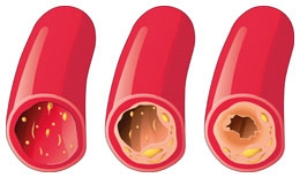Peripheral Vascular Disease
 Peripheral arterial disease (PAD) is a condition that affects the arteries that supply the legs, the arteries become narrowed and hardened with fatty deposits or plaques and the blood flow to the legs is reduced.
Peripheral arterial disease (PAD) is a condition that affects the arteries that supply the legs, the arteries become narrowed and hardened with fatty deposits or plaques and the blood flow to the legs is reduced.
When the blood flow through these diseased arteries is reduced, it causes calf pain during walking. If the blood is reduced to a critical extent, then there would be pain at rest and there may even be ulcers or gangrene areas on the feet. These blocked arteries are a warning sign that other arteries, for example those in the heart, brain may also be blocked, thus increasing the risk of stroke and heart attacks.
Risk factors of peripheral vascular disease:
Age, smoking, high cholesterol, hypertension, family history (stroke, heart problems or vascular disease), diabetes mellitus and coronary heart disease. The disease affects males more than females due to the cardio-protective effects of estrogen.
WHAT ARE THE SYMPTOMS?
- Intermittent claudication-pain, tightness of the legs after a certain period of walking, usually the pain is in the calf but can occur in the thigh or buttocks
- Rest pain-severe pain, usually nocturnal and tends to occur over the toes and front of the foot
- Tissue loss-presence of ulcer or gangrene and even a persistent wound after a minor injury
HOW IS IT DIAGNOSED?
Diagnosis is made after taking a concise history of the patient’s symptoms as well as examining the peripheral or foot pulses of the patient. Depending on the severity of the disease, further tests can be performed:
- ABI( ankle-brachial index)/TPI(Toe –pressure index)-the systolic blood pressure of the arm is compared to that of the foot/toe and a ratio is calculated, this ratio gives an estimate of the amount of blood flow to the feet/toes.
- Duplex scan-a combination of ultrasound and flow imaging that reveals a diagrammatic picture of the blood flow in the vessels supplying the legs. This scan is safe and effective, it does not require any contrast/dye and no preparations are required prior to the scan
- Direct Angiography-a contrast or dye is injected into the vessels of the leg and x rays are taken to outline the vessels of the leg.
- CT Angiogram/MR Angiogram-contrast is injected via a needle in the arm and pictures are taken of the vessels in the body/leg.
WHAT IS THE TREATMENT?
Non-surgical
1) Lifestyle modification involving regular exercise and control of risk factors
- Hypertension-proper management and monitoring
- Diabetes Mellitus-proper management and monitoring
- High cholesterol-control diet and reduce cholesterol intake
- Stop smoking
2) Anti-platelet therapy helps to thin the blood and reduce the long term risk of stroke, heart attack and peripheral vascular disease ( eg aspirin, plavix, ticlid)
3) Other medication-there are some drugs which can help improve the symptoms of intermittent claudication. ( eg trental, praxilene)
Surgical
1) Angioplasty/stenting
Using needles, the artery in the groin is punctured and blockages in the arteries are “opened” using angioplasty (balloon) or stents. This procedure can be performed under sedation and has less complications as compared to surgery.
2) Bypass surgery
Surgery is performed under general anaesthesia. A conduit or tube, either the patient’s native vein or a artificial tube( graft) is used to “re-route” blood flow, avoiding the area of disease thereby improving the blood flow to the feet.
3) Endarterectomy
Surgery is performed under general anaesthesia, the affected artery is “opened” and the blockage usually comprising of cholesterol and atheromatous plaques is removed. The artery is then sewn closed.
4) Amputation/Debridement
Amputation is performed in life saving situations when the infection( of the gangrene areas) has spread and there is overwhelming sepsis or when wounds do not heal even after angioplasty/bypass.
Debridement is a minor surgery whereby gangrene areas are excised to ensure wound recovery. This is usually performed after the blood flow to the legs have been improved either with angioplasty or bypass surgery.
Dr Sanjay Nalachandran, Vein & General Surgery Clinic
Further Reading
The article above is meant to provide general information and does not replace a doctor's consultation.
Please see your doctor for professional advice.
